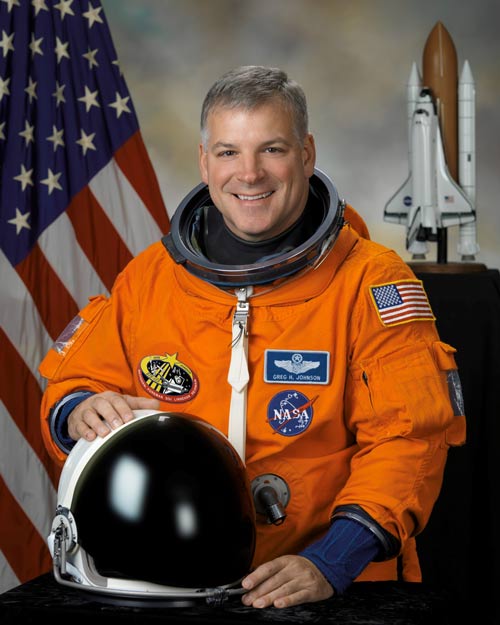STS-123 Pilot: Gregory H. Johnson

NAME: Gregory H. Johnson (Colonel, U.S. Air Force)
NASA Astronaut
PERSONAL DATA: Born on May 12, 1962 in South Ruislip, Middlesex, United Kingdom. Married to the former Cari M. Harbaugh of Lubbock, Texas. They have three children: Matthew, Joseph and Rachel. Recreational interests include traveling, biking, golfing, music, duplicate bridge, and woodworking.
EDUCATION: Park Hills High School, Fairborn, Ohio, 1980.
B.S., Aeronautical Engineering, U.S. Air Force Academy, 1984.
M.S., Flight Structures Engineering, Columbia University, 1985.
M.B.A., University of Texas (Austin), 2005.
SPECIAL HONORS: 2005 Stephen D. Thorne Top Fox Safety Award, 2005 Dean’s Award for Academic Excellence – McCombs School of Business, NASA Superior Performance Award, 1996 Lieutenant General Bobby Bond Award – Top USAF test pilot, Distinguished Graduate USAF Test Pilot School Class 94A, Onizuka Award Class 94A, 1985 Guggenheim Fellow to Columbia University, 1984 Distinguished Graduate with Honors – USAF Academy, 1980 Valedictorian : Park Hills High School, Eagle Scout. Military decorations: Distinguished Flying Cross, Meritorious Srvc Medals (2), Air Medals (4), Aerial Achievement Medals (3), USAF Commendation Medal, USAF Achievement Medals (2).
MILITARY EXPERIENCE: Johnson received his commission from the United States Air Force Academy in May 1984 and was designated an Air Force pilot in May 1986 at Reese Air Force Base, Texas. He was retained as a T-38A instructor pilot at Reese until 1989, when he was selected for an F-15E Eagle assignment. After completing initial F-15E training, Johnson was assigned to the 335th Fighter Squadron, at Seymour Johnson Air Force Base, North Carolina. In December 1990, Johnson deployed to Al Kharj, Saudi Arabia, flying 34 combat missions in support of Operation Desert Storm. In December 1992, he was again deployed to Saudi Arabia for three months, flying an additional 27 combat missions in support of Operation Southern Watch. In 1993, he was selected for Air Force Test Pilot School at Edwards Air Force Base, California, graduating in December 1994. After graduation, he was assigned to the 445th Flight Test Squadron at Edwards, where he flew and tested F-15C/E, NF-15B, and T-38A/B aircraft. In August 1997, he was assigned to Maxwell Air Force Base, Alabama, to attend Air Command and Staff College.
He has logged over 4,000 flight hours in more than 40 different aircraft.
NASA EXPERIENCE: Selected by NASA in June 1998, he reported for training in August 1998. He completed Astronaut Candidate Training in 2000. Following initial training and evaluation, astronaut candidates receive technical assignments within the Flight Crew Operations Directorate before being assigned to a space flight. In 2000, Johnson was assigned as a Technical Assistant to the Director, Flight Crew Operations Directorate (FCOD). In conjunction with that position, Johnson was assigned to the Shuttle Cockpit Avionics Upgrade (CAU) council – redesigning cockpit displays for future Space Shuttle missions. His design and evaluation work with CAU has continued to the present.
In 2001, Johnson was reassigned from FCOD to the Space Shuttle Branch, where he’s held various positions including direct support to the crews of STS-100 and STS-108, chief of shuttle abort planning and procedures for contingency scenarios, and ascent procedure development. He also was a key player on several “tiger teams” during the investigation into the cause of the Columbia accident in 2003. Johnson was the astronaut representative to the External Tank (ET) foam impact test team that eventually proved that ET foam debris on ascent could critically damage the shuttle’s leading edge thermal protection system. In 2004, Johnson was designated as the Deputy Chief of the Astronaut Safety Branch, focusing on all aspects of Space Shuttle, ISS, and T-38 safety, with special emphasis on improving specific operational procedures and techniques to make astronauts safer in all three vehicles. In 2005, Johnson was appointed as a crew representative supporting the design and testing of NASA’s newest spacecraft, the Crew Exploration Vehicle. Johnson is assigned as pilot on the STS-123 mission that will deliver the Japanese Logistics Module and the Canadian Special Purpose Dexterous Manipulator to the International Space Station.
Last Updated: January 2008
- NEW VIDEO: Danger on the Pad: Shuttle Astronauts Practice Escape Drill
- VIDEO: ESA's New Science Laboratory
- Complete Space Shuttle Mission Coverage
Get the Space.com Newsletter
Breaking space news, the latest updates on rocket launches, skywatching events and more!
Join our Space Forums to keep talking space on the latest missions, night sky and more! And if you have a news tip, correction or comment, let us know at: community@space.com.

The National Aeronautics and Space Administration (NASA) is the U.S. government agency in charge of the civilian space program as well as aeronautics and aerospace research. Founded in 1958, NASA is a civilian space agency aimed at exploring the universe with space telescopes, satellites, robotic spacecraft, astronauts and more. The space agency has 10 major centers based across the U.S. and launches robotic and crewed missions from the Kennedy Space Center in Cape Canaveral Florida. It's astronaut corps is based at the Johnson Space Center in Houston. To follow NASA's latest mission, follow the space agency on Twitter or any other social channel, of visit: nasa.gov.









